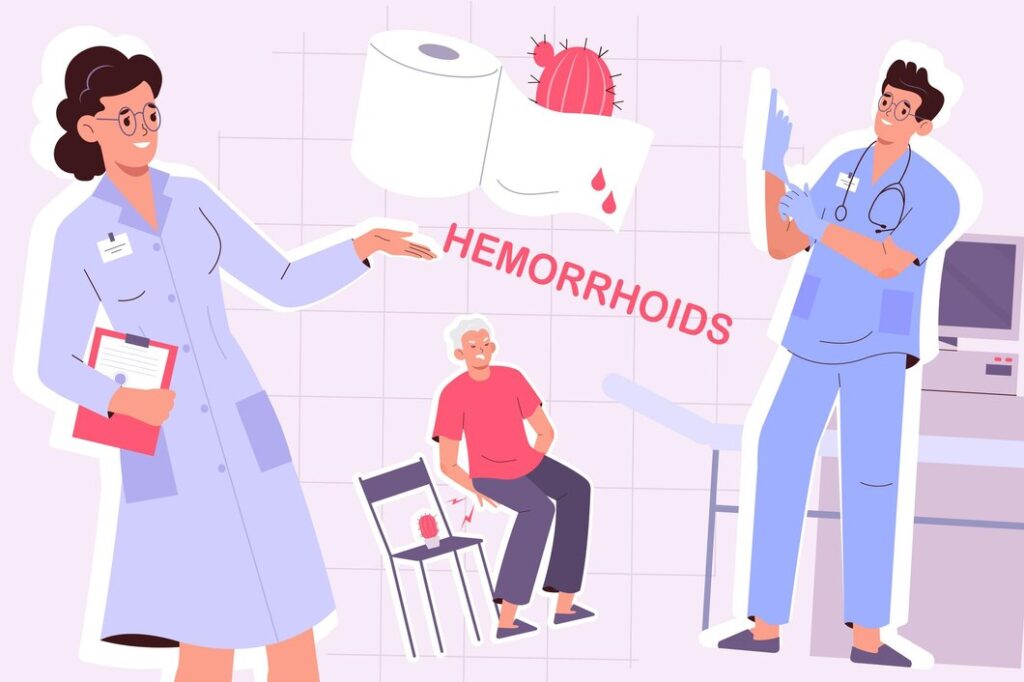FREE SHIPPING OVER $50
Hemorrhoid Banding: Everything You Need to Know | Procedure & Recovery
Hemorrhoids, also known as piles are swollen veins in the lower part of the rectum and anus. They can cause pain, itching, bleeding, and discomfort during bowel movements. But there’s a solution that’s been gaining traction called hemorrhoid banding. Hemorrhoid banding also known as rubber band ligation or hemorrhoid ligation, offers a minimally invasive solution to this problem. But what exactly is hemorrhoid banding? How does it work? And most importantly, is it painful? Let’s delve into the details.
Key Takeaways:
- Hemorrhoid Banding: A non-surgical, outpatient procedure with a high success rate for treating hemorrhoids.
- Side Effects: Temporary discomfort, bleeding, and a sensation of fullness in the rectum.
- Worth Considering: Given its effectiveness, short recovery time, and cost, it’s a worthwhile option for many patients. Always consult a healthcare professional before making decisions.

What is Hemorrhoid Banding
Hemorrhoid banding is a non-surgical medical procedure used to treat uncomfortable or painful hemorrhoids. Here’s what you need to know:
- The process involves the placement of a small rubber band around the base of the hemorrhoid.
- This cuts off blood flow and causes the hemorrhoid to shrink and eventually fall off.
- The procedure is typically done in a doctor’s office and doesn’t require anesthesia.
Benefits and Side Effects of Hemorrhoid Banding
Benefits
Hemorrhoid banding, or rubber band ligation, is a widely used and effective treatment for internal hemorrhoids. Here are some of the benefits:
- Non-surgical: Hemorrhoid banding is a non-surgical procedure, which means it’s less invasive than traditional hemorrhoid surgeries.
- Outpatient procedure: The procedure is typically performed in a doctor’s office, and patients can usually return home the same day.
- High success rate: Hemorrhoid banding has a high success rate. It’s considered one of the most effective treatments for internal hemorrhoids.
- Prevents recurrence: The procedure not only treats existing hemorrhoids but also helps prevent them from coming back.
Side Effects
While hemorrhoid banding is generally safe, like any medical procedure, it does have potential side effects. These may include:
- Pain or discomfort: Some patients may experience pain or discomfort in the rectal area after the procedure. This is usually temporary and can be managed with over-the-counter pain relievers.
- Bleeding: Some bleeding may occur after the procedure, especially after bowel movements. This is normal and should stop within a week.
- Anal fullness: Patients may feel a sense of fullness in the rectum or lower abdomen. This sensation is normal and should subside within a few hours.
The Hemorrhoid Banding Procedure
The hemorrhoid banding procedure is relatively straightforward. Here’s a more detailed step-by-step breakdown of the procedure:
- Preparation: Before the procedure, your doctor may ask you to empty your bowels. You’ll also discuss any medications you’re taking, as some may need to be stopped temporarily.
- Anesthesia: Hemorrhoid banding is usually performed under local anesthesia, which means you’ll be awake but the area will be numbed. In some cases, sedation or general anesthesia may be used.
- Procedure: The doctor will use a device called a proctoscope to visualize the area. Once the hemorrhoid is located, a special instrument is used to place a rubber band around the base of the hemorrhoid. The band is tight enough to cut off the blood supply but not so tight as to cause severe pain.
- Post-Procedure: After the procedure, you might feel fullness or a dull ache in the rectum for the first 24 hours, but over-the-counter pain medication can help. You’ll be able to resume most normal activities the same day, but you should avoid heavy lifting and strenuous exercise for a week.
- Recovery: The banded hemorrhoid will usually fall off within a week. You might not even notice when this happens or you might find the band in the toilet after a bowel movement.
Hemorrhoid banding is considered a safe and effective treatment for hemorrhoids, with a success rate of about 80%. However, as with any medical procedure, there are risks and potential complications, so it’s important to discuss these with your doctor.
Managing Pain After Hemorrhoid Banding
Managing pain after hemorrhoid banding is an important part of the recovery process. Here are some key points to keep in mind:
- Pain Management: Most patients experience a dull ache for about 5 hours after the procedure. This is normal and can be managed with regular painkillers, such as paracetamol. Some doctors recommend taking Tylenol (acetaminophen) every four to six hours. However, avoid taking any medications that may thin the blood (Aspirin or Aspirin-containing products, NSAIDS such as Advil, Motrin, etc.) for the next two weeks to minimize your risk of bleeding following the procedure.
- Bleeding: Bleeding may be observed for 7-10 days post the procedure. This is normal and should stop within a week. If you notice excessive bleeding, severe pain, or fever, contact your doctor immediately.
- Activity: Avoid strenuous work for 24-48 hours after the procedure. Do not lift anything heavy for 24-48 hours. Avoid straining while defecating because it can lead to more hemorrhoids.
- Anal Fullness: You may also feel a sense of anal fullness. This sensation is normal and should subside within a few hours.
Does Hemorrhoid Banding Hurt
As a general rule, it shouldn’t hurt to have a band placed around your hemorrhoid. That’s because there aren’t many nerve endings in the area where internal hemorrhoids are. You’re more likely to feel sensations of pressure rather than pain. For example, you’ll probably notice when the doctor inserts an anoscope into your rectum to begin the procedure. The next step, though, is taking hold of the hemorrhoidal tissue. Fortunately, an instrument like the Adler Ligator (AL 9000) accomplishes that with gentle suction that shouldn’t hurt at all. Since there aren’t many sensitive nerves around the base of a hemorrhoid, placing the band shouldn’t be painful either. If you do feel any cramping or sharp pain, be sure to let the doctor know right away. A small adjustment of the band’s placement will usually resolve the problem quickly.
Compared to many other hemorrhoid treatments, such as excision surgeries, hemorrhoid banding offers a much less painful recovery. Even still, you may need a few days to feel like yourself again. Some people do experience some rectal pain for a day or two after the procedure.
Is Hemorrhoid Banding Worth It
Deciding whether hemorrhoid banding is worth it depends on several factors, including the severity of your hemorrhoids, your personal health situation, and your comfort with the procedure. Here are some points to consider:
- Effectiveness: Hemorrhoid banding has a high success rate and is considered one of the most effective non-surgical treatments for hemorrhoids. It can provide significant relief from pain and discomfort.
- Recovery Time: The recovery time for hemorrhoid banding is typically short, with most people able to return to their normal activities the same day. This can make it a more appealing option than surgical treatments, which often require a longer recovery period.
- Cost: Hemorrhoid banding is generally less expensive than surgical treatments for hemorrhoids. However, the cost can vary depending on your healthcare provider and insurance coverage.
Hemorrhoid banding can be a worthwhile treatment for many people suffering from hemorrhoids. However, it’s important to discuss all your treatment options with your healthcare provider to determine the best course of action for your specific situation.
Related Articles
If you found this blog post insightful, explore more by delving into our related articles:
- Piles Self-Treatment Hacks for Quick Relief
- The Best Kegel Exercises for Men to Combat Erectile Dysfunction
- Natural Ways to Ease Ulcerative Colitis Flare-Ups
- 10 Natural Ways to Lower Cortisol Levels: Reclaim Your Peace
- Top 10 Best Supplements for Bloating in 2024
- How Gut Health and Probiotics Affect Your Overall Well-being
Sources
- What to know about hemorrhoid banding. www.medicalnewstoday.com, https://www.medicalnewstoday.com/articles/326742
- Banding. www.guysandstthomas.nhs.uk, https://www.guysandstthomas.nhs.uk/health-information/piles-haemorrhoids/banding
- Hemorrhoid Banding: A Cost-Effectiveness Analysis. journals.lww.com, https://journals.lww.com/dcrjournal/Abstract/2019/09000/Hemorrhoid_Banding__A_Cost_Effectiveness_Analysis.10.aspx



